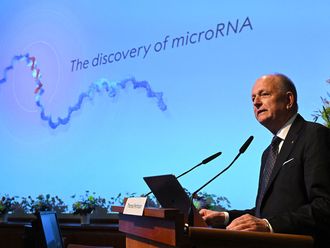
Dubai: Food allergy among children is on the increase and it occurs especially during infancy and most commonly during the first six years.
But it may also may occur at any age. At a Friday brunch at a seaside restaurant, your child enjoys a plate of shrimps and before you know, his lips start to swell up and he starts to gasp for breath.
Food allergy generally affects between 6-8 per cent of children, says Dr Mandar V. Bichu, specialist paediatrician. This is in comparison to just two per cent of the adult population who will experience food allergies, he says.
A study done in the US has found that, alarmingly, more children are suffering from food allergies today. But fortunately, many may outgrow their allergies to foods such as peanuts or their intolerance to lactose in milk. Allergies to peanuts and seafood, normally, can also be life-long.
The massive study involved 38,000 families of children who are younger than 18 years and it was found that at least 8 per cent of the children were allergic to some food.
Medical professionals say the allergies to certain foods is due to the increasing environmental pollution. It could also be due to certain additives in our foods that are contributing to its increase among children.
One reason why this sudden reaction occurs after eating a certain food is due to the production of antibodies called IgE, produced by the child’s immune system. This type of allergy disease is inherited.
Today, a third of the population in Western countries excludes certain foods from their children’s diets because of allergic reactions. Food companies are required to label the foods and list the ingredients to help parents exclude the allergic foods.
Though quite common during childhood, food allergy and food intolerance are often under-diagnosed by medical practitioners and despite the growing threat, many parents are still unaware of the risks of either disorder, says Dr Bichu.
He says that if there is a family history of allergies and the presence of other allergic problems in the child such as eczema or asthma, it adds to the risk.
In a food allergy, the immune system reacts in an exaggerated way to otherwise harmless proteins in food, which leads to adverse symptoms or signs following ingestion of that food. Such adverse reactions to food can also happen without the involvement of the immune system.
“Food intolerance, on the other hand, is a broader term used to describe all conditions when some food consistently and repeatedly causes adverse signs and symptoms,” says Dr Bichu.
The symptoms of food allergy often manifest within minutes of ingestion of the particular food. Sometimes, they may be delayed up to few hours or days.
Commonly, the skin first reacts to the food allergy in the form of hives, itchy rash and swelling. It also affects the respiratory system and there would be symptoms such as coughing, wheezing, sneezing and nasal congestion in the child.
Anaphylactic shock
It may affect the gastrointestinal system and the child could have nausea, vomiting, diarrhoea or abdominal pain. In certain cases, the worsening of asthma, eczema or migraine might also be observed. In infants, colic, vomiting or growth failure might be the pointers to food allergy.
Parents have to be aware that a very severe and life-threatening allergy can sometimes occur within minutes of the ingestion of certain foods.
This anaphylactic shock is fortunately a rare complication and is particularly liable to occur with peanuts, fish, shellfish or eggs. The child may experience a sudden choking sensation, breathlessness, itching or burning.
The face and mouth may swell, there will be vomiting and the blood pressure will fall. This can occur with just a single morsel of the offending food.
Immediate resuscitation, with administration of adrenaline, oxygen and bronchodilators, are required to treat this. The anaphylactic type of allergy can often be life-long and such patients should wear alert bracelets and should learn how to self-administer adrenaline on recognition of symptoms.
Diagnosis
Dr Bichu says that inspite of technological advances, the diagnosis of food allergy is still mainly clinical. A careful observation by parents and a detailed medical history is the key to diagnosis.
“You just have to see what kind of food is inducing adverse reaction and whether it is repetitive. Note the quantity, the cooking pattern and the timing of the symptoms. Here, it is essential to maintain a food diary,” he advises.
“Elimination diet and food challenge” is an important diagnostic test where the offending food is eliminated from diet for two weeks.
If any improvement is seen after this, then the effects on re-introduction of the same food in small, increasing quantities are noted to confirm or disprove the allergy. The ‘double-blind’ food challenge’ offers food extracts in gelatinised capsules. This method is more expensive but not necessarily more accurate.
Any food challenge should be carried out in a medically supervised set-up where emergency resuscitation is possible.
Allergy tests like skin-prick tests or measurement of antibody levels are expensive, often inconclusive due to false positive or negative results and are more useful only for immediate type of allergic reactions. They should be done under the guidance of a doctor specialised in such cases, he says.











